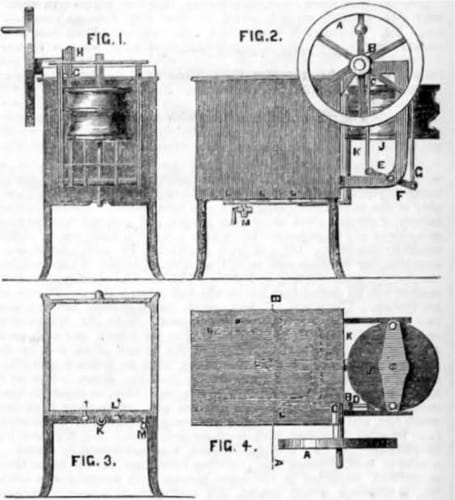Nearly half a century before the world’s first electric domestic washing machine was introduced by US inventor Alva John Fisher, his British namesake, Nottinghamshire engineer John Fisher unveiled a novel design for a domestic washing machine that employed a strikingly different concept to today’s rotary machines.

‘This invention,’ wrote The Engineer, ’consists in combining with a tub or other suitable vessel, for containing the articles to be treated, a blowing apparatus for forcing atmospheric air or any suitable gas for depuritating, bleachingor otherwise treating the contents of the tub or vessel, whether soap ley, plain, or acidulated water or other liquor be employed.
The article explained that during operation the tub is partially filled with hot soapy water, the clothes are placed into this water, and then a “blowing apparatus” attached to the vessel by a number of small pipes is used to force air through the ’through and amongst the articles contained therein.’
’It is well known,’ continued The Engineer, ’that linen and other articles of clothing, when worn or exposed to the impurities of the atmosphere, become soiled through the deposit upon them of sooty and other extraneous particles, which, by the friction or wear, get rubbed into them, and hence require cleaning· It is claimed as the chief distinguishing feature in this invention, that the process employed for getting rid of such impurities is the reverse of that by which such articles have become soiled as above described, viz., by the agency or currents or air, which, being forced through the ley in which the clothes are immersed, the particles of dirt are, as it were, thus blown out or dischargedfrom the fabric, and entirely removed from the surface thereof by the action which ensues.’
The Engineer reported that the technique – which didn’t use the violent forces and rubbing associated with existing “scrubbing” techniques – was ideal for even the most delicate fabrics. ’By the use of this machine all kinds ofwashing, from the coarsest to the finest of linens may be accomplished without injuring the articles in the slightest degree; also no buttons are rubbed off, and the saving in soap is very great.’




Glasgow trial explores AR cues for autonomous road safety
They've ploughed into a few vulnerable road users in the past. Making that less likely will make it spectacularly easy to stop the traffic for...